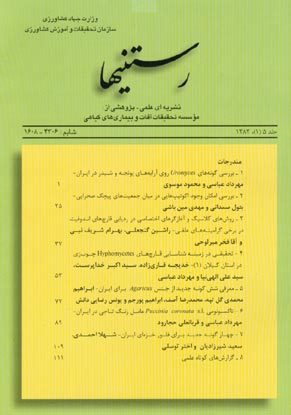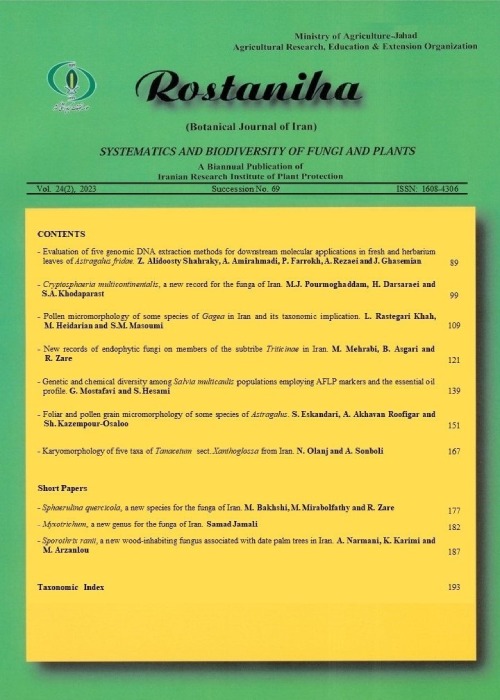فهرست مطالب

نشریه رستنیها
سال چهارم شماره 2 (پیاپی 17، پاییز و زمستان 1382)
- تاریخ انتشار: 1382/10/28
- تعداد عناوین: 8
-
-
صفحه 1
در این تحقیق چهار نمونه مربوط به فلور قارچ های ناحیه کرج که طی سالهای 1380-1379 جمع آوری گردیده است، مورد بررسی قرار گرفت. در گزارش حاضر گونه های Diplosporonema delastrei روی Silene latifolia subsp. persicaو Piggotia ulmi روی Ulmus sp. ، با اسامی جدید برای فلور قارچ های ایران معرفی می گردند. برای برخی از گونه ها، میزبان های جدیدی معرفی شده است. علاوه بر این، گونه های Marssonina kriegeriana روی Salix sp. ، Septoria polygonorum روی Polygonum persicaria ، Stagonospora dolosa روی Phragmites communis ، Platychora ulmi روی sp.Ulmus ، Polystigmina sp. روی Cerasus sp. و Ramulariadecipiens روی Rumex sp. گزارش شده اند.
کلیدواژگان: فلور، قارچ، میکرومیست، کرج، ایران -
صفحه 2
در ادامه مطالعه روی گونه های جنس Alternaria در ایران که از سال 1379 آغاز شده است، بیش از 500 جدایه از میزبان ها و مکان های مختلف جداسازی و مورد مطالعه تاکسونومیکی قرارگرفتند. در این مقاله هفت گونه از آنها معرفی و توصیف می شوند. از بین آنها، گونه های Alternaria chlamydospora، A. cinerariae،A. infectoria ، A. mouchaccae و A. porri برای اولین بار از ایران گزارش می شوند. گونه های A. brassicae و A. japonica هم که قبلا از ایران نام برده شده اند، مجددا توصیف گردیدند.
کلیدواژگان: Alternaria، تاکسونومی، قارچ، ایران -
صفحه 3
تاکنون، تحقیقاتی در مورد سیتولوژی خزه (بریوفیت) های ایران انجام نگرفته است، لذا در این تحقیق، مطالعات کروموزومی روی پنج گونه از خزه ها شامل دو حالت (expression) و یک واریته به اسامی زیر برای نخستین بار در کشور صورت گرفت: Amblystegium riparium (Hedw.) B.S.G. “brevipes ” حالت(n=20) A. riparium (Hedw.) B.S.G. “pennellii ” حالت(n=9، 9+m، 9+2m) A. serpens (Hedw.) B.S.G. (n=20) Campylium stellatum (Hedw.) C. Jens. in Lange var. protensum (Brid.) Bryhn ex Grout (n=10) Fissidens taxifolius Hedw. (n=12+m) Orthothecium intricatum (Hartm.) Schimp. in B.S.G. (n=11)
کلیدواژگان: شمارش کروموزومی، خزه، سیتولوژی، ایران -
صفحه 4
اثر تیمارهای متفاوت شوری سدیم کلرید (0، 50، 100، 200 و 300 میلی مولار) در مراحل مختلف رشد و نمو (پنجه زنی، تورم غلاف، گلدهی و گرده افشانی) در دو رقم گندم (قدس: حساس به شوری؛ بولانی: مقاوم به شوری) بر الگوی الکتروفورزی SDS-PAGE پروتئین های برگ در شرایط گلخانه ای مورد بررسی قرار گرفت. در مجموع، در پاسخ به تیمارهای شوری مشاهده شد که کاهش شدت و حذف باندهای پروتئینی در عصاره های پروتئینی برگ قدس چشمگیرتر از برگ بولانی بود. برعکس، افزایش شدت باندهای پروتئینی در برگ بولانی قابل ملاحظه تر از برگ قدس بود. بنابراین، به نظر می رسد بولانی توانایی بیشتری در حفظ پروتئین های برگ در پاسخ به شوری دارد. بدین ترتیب از دیدگاه بیوشیمیایی نیز می توان بولانی را به عنوان رقم مقاومتر به شوری معرفی نمود.
کلیدواژگان: تنش شوری، گندم، پروتئین های برگ -
صفحه 5
-
صفحه 6
طی مطالعه فلور زنگ های پارک ملی گلستان واقع در شمال شرقی ایران، آرایه های متعددی از جنس های مختلف راسته زنگ ها شناسایی گردیدند. از بین آرایه های شناسایی شده یک زیر گونه و پنج گونه شامل Phragmidium sanguisorbae subsp. mediterraneum ،Sanguiosorba minor، Puccinia difformis on Galium aparine، P. jasmini ، Jasminum fruticans، P. rhylismoides ، Thalictrum isopyroides، Uromyces mogianensis ، Fri/ii/aria gibbosa وU. transcaspicus ، As/raga/us citrinus به عنوان اعضای جدید برای فلور زنگ های ایران گزارش می شوند. شرح و تصاویر میکروسکوپی از هاگ های مراحل مختلف گونه های فوق ارایه می گردد.
کلیدواژگان: قارچ، زنگ، فلور، پارک ملی گلستان -
صفحه 7
به منظور مطالعه روابط فیلوژنتیک بین جنس های Microsphaera و Erysiphe s. lat. توالی ناحیه ITS روی DNA ریبوزومی همراه با ناحیه 5.8S برای 23 تاکسون به دست آمد. برای این مطالعه DNA کل از آسکوکارپ یا میسلیوم با روش Chelax استخراج شد. سپس با استفاده از واکنش زنجیری پلی مراز ناحیه فوق دو بار به وسیله آغازگرهای ITS5، ITS1 و P3 تکثیر گردید و توالی یابی مستقیم ناحیه ITS با استفاده از توالی یاب Applied Biosystems 373A انجام گردید. نتایج این مطالعه نشان داد که Erysiphe sect. Erysiphe و گونه های Microsphaera ارتباط فیلوژنتیک بسیار نزدیکی با هم دارند و در یک گروه قرار می گیرند.
کلیدواژگان: سفیدک های سطحی، فیلوژنی، rDNA، Erysiphe، Microsphaera -
صفحه 8
گونه جدیدی از جنس ختمی (تیره Malvaceae) به نام Alcea ilamicaاز استان ایلام شرح داده می شود. گونه جدید متعلق به بخش Pterocarpi است. اختلافات این گونه با سایر گونه های ایرانی و پراکندگی جغرافیایی آن مورد بحث واقع می شود. مطالعه میکروسکوپ الکترونی (SEM) از کرک های فرچه ای در این گونه نشان داد که Alcea ilamicaبه A. aucheri Alef. خیلی نزدیک است و احتمالا از آن مشتق شده است. تصاویر و نقشه پراکندگی گونه های فوق ارایه شده است (متن کامل مقاله در قسمت انگلیسی آورده شده است).
کلیدواژگان: Malvaceae، گونه جدید، ختمی، Alcea، میکروسکوپ الکترونی، ایران، کرک فرچه ای
-
Page 1
In this study, four specimens belonging to Karaj mycoflora were examined. According to the results, two form species; Diplosporonema delastrei, on Silene latifolia subsp. persica and Piggotia ulmi, on Ulmus sp. are reported with new names. For some of the identified fungal specimens, new hosts (matrix nova) are introduced. Moreover, many taxa such as , Marssonina kriegeriana on Salix sp., Septoria polygonorum on Polygonum persicaria, Stagonospora dolosa on Phragmites communis, Platychora ulmi on Ulmus sp., Polystigmina sp. on Cerasus sp. and Ramularia decipiens on Rumex sp., are studied and documented as less known form species.
Keywords: Mycoflora, fungi, micromycetes, Karaj, Iran -
Page 2
In the continuation of studies on Alternaria species, some 500 isolates were obtained from seeds, soil and plant parts from various localities of Iran. Prior to morphological examination, pure cultures were obtained by single conidium and single chain methods. Descriptions for each taxon are based on cultures developed on potato carrot agar. Inoculated plates were incubated at 23-25°C under a cool-white fluorescent light/dark cycle of ca. 8/16 hrs. Microscopic examinations were carried out after 5-7 days. Conidiophores, conidia and sporulation patterns were studied and recorded. Seven species of Alternaria are introduced and described in the present investigation, five of which (A. chlamydospora, A. cinereariae, A. infectoria, A. mouchaccae and A. porri) are new to the mycoflora of Iran. Other two species, A. brassicae and A. japonicae, that have been reported from Iran previously, are described here with.
Keywords: Alternaria, fungi, taxonomy, Iran -
Page 4
Effect of various NaCl treatments (0, 50, 100, 200, and 300 mM) at different growth and development stages (tillering, boot swellen, flowering and anthesis) in two wheat cultivars (Ghods: salt sensitive, Boolani: salt resistant) on SDS-PAGE electrophoretic pattern of leaf proteins was studied under greenhouse conditions. Generally, in response to salinity treatments, the decrease in protein synthesis in Ghods was more than that of Boolani and the increase of protein bands in Boolani was more than that of Ghods. Therefore, it seemed that Boolani had more ability in maintaining its leaf proteins in response to salt. Thus, from biochemical point of view, Boolani was introduced as a cultivar with more resistance to salinity stress.
Keywords: salt sterss, Wheat, foliar proteins -
Page 6
Based on the floristic study of rust fungus flora (Uredinales) ofGolestan National Park, located in the Northeast of Iran, 68 rust taxa were recognized. Of these, one subspecies and five species viz. Phragmidium sanguisorbae subsp. mediterraneum on Sanguiosorba minor, Puccinia difformis on Galium aparine, P. jasmini on Jasminum fruticans, P. rhylismoides on Thalictrum isopyroides, Uromyces mogianensis on Fri/ii/aria gibbosa and U. transcaspicus on As/raga/us citrinus are recorded as new additions to Iranian rust flora. Moreover, Thalictrum isopyroides and Fri/ii/aria gibbosa are recorded as new hosts (Matrix Nova) for Puccinia rhytismoides and Uromyces mogianensis, respectively.
Keywords: Fungus, Rust, flora, Golestan National Park -
Page 7
To study the phylogenetic relationships between Erysiphe s. lat. and Microsphaera, the nucleotide sequences of internal transcribed spacers ofrDNA including 5.8S rDNA gene were determined for 23 taxa. The results showed that Erysiphe. section Erysiphe and Microsphaera are closely related and clustered together with strong bootstrap support (100%). All oftaxa belonging to this group produce conidia singly. Whereas, these genera are distinguished by the morphology of appendages which is dichotomously branched in Microsphaera and mycelioid in Erysiphe. Erysiphe. sect. Golovinomyces and Erysiphe. sect. Galeopsidis, both of which are well characterized by conidia produced in chains, formed two different groups. The percentages of sequence divergence ranged from 2 to 7.8% between Microsphaera and Erysiphe. sect. Erysiphe.
Keywords: Erysiphe, Microsphaera, phylogeny, powdery mildew, rDNA sequences -
Page 8
A new Alcea species A. ilamica (Malvaceae), is described from Ilam province of Iran. The new species belongs to the sect. Pterocarpa. Differences from other Iranian species and its geographical distribution are discussed. SEM study of penicillate hairs showed that, A. ilamica is very similar to A. aucheri but has advanced characters. Illustrations and a distribution map are given '>A new Alcea species A. ilamica (Malvaceae), is described from Ilam province of Iran. The new species belongs to the sect. Pterocarpa. Differences from other Iranian species and its geographical distribution are discussed. SEM study of penicillate hairs showed that, A. ilamica is very similar to A. aucheri but has advanced characters. Illustrations and a distribution map are given.
Keywords: Malvaceae, New species, Alcea, SEM, Iran, penicillate hair


